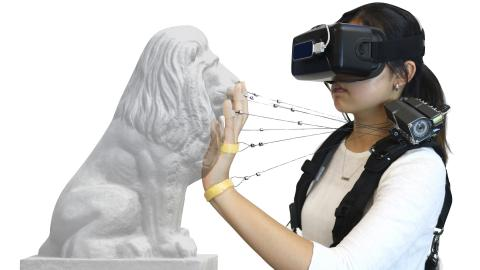Apr 29 2020
Existing virtual reality systems have the ability to offer captivating visual experiences. However, they do not often allow users to feel anything—specifically appliances, furniture, and walls.
 A new device developed at Carnegie Mellon University uses multiple strings attached to the hand and fingers to simulate the feel of obstacles and heavy objects in virtual reality environments. Image Credit: Carnegie Mellon University.
A new device developed at Carnegie Mellon University uses multiple strings attached to the hand and fingers to simulate the feel of obstacles and heavy objects in virtual reality environments. Image Credit: Carnegie Mellon University.
Researchers at Carnegie Mellon University have developed a device that makes use of multiple strings fixed to the hand and fingers to simulate the feel of heavy objects and obstacles.
For instance, the device locks the strings when the user’s hand reaches close to a virtual wall, thus simulating the feel of touching the wall. Likewise, the string mechanism allows users to sense a virtual sculpture’s contours, feel the resistance while pushing on a piece of furniture, or even give a high five to a virtual character.
According to Cathy Fang, who will graduate from CMU next month with a joint degree in mechanical engineering and human-computer interaction, the shoulder-mounted device leverages spring-loaded strings to minimize weight, reduce battery power usage, and maintain costs low.
Elements such as walls, furniture and virtual characters are key to building immersive virtual worlds, and yet contemporary VR systems do little more than vibrate hand controllers.
Chris Harrison, Assistant Professor, Human-Computer Interaction Institute, Carnegie Mellon University
Co-authors of the study Harrison, Fang, Robotics Institute engineer Matthew Dworman, and HCII doctoral student Yang Zhang report that following user evaluation of the multistring device, it was found to be more realistic compared to other haptic techniques.
I think the experience creates surprises, such as when you interact with a railing and can wrap your fingers around it. It’s also fun to explore the feel of irregular objects, such as a statue.
Cathy Fang, Researcher, Carnegie Mellon University
The research paper authored by the team has been chosen as a best paper by the Conference on Human Factors in Computing Systems (CHI 2020), scheduled for this month but canceled due to the COVID-19 pandemic. The paper has been published in the conference proceedings in the Association for Computing Machinery’s Digital Library.
Although other research teams have made use of strings to generate haptic feedback in virtual worlds, they have generally used motors to control the strings. For the CMU team, motors would not hold good as they imagined a system not just sufficiently lightweight to be worn by users but also affordable.
The downside to motors is they consume a lot of power. They also are heavy.
Cathy Fang, Researcher, Carnegie Mellon University
As an alternative to motors, the researchers used spring-loaded retractors, analogous to those used in ID badges or key chains. A ratchet mechanism that can be quickly locked using an electrically controlled latch was added. The strings are maintained firmly by the springs and not motors. Since the latch can be engaged using less electrical power, the system can be run on battery power and is energy efficient.
The team experimented with several different strings and string placements. They then concluded that the best experience was gained when one string was attached to each fingertip, one to the wrist, and one to the palm.
A Leap Motion sensor attached to the VR headset tracks the movements of hands and fingers. Upon sensing a user’s hand close to a virtual wall or other obstacles, the ratchets get engaged in a sequence appropriate for those virtual objects. The latches get disengaged when the users withdraw their hand.
The weight of the complete device is less than 10 ounces. The team predicts that upon mass-production, each unit would be priced less than $50.
According to Fang, the system would be appropriate for VR games and experiences that involve interaction with physical objects and obstacles, such a maze. In addition, it can be used for virtual museum visits. Furthermore, when it is not always feasible to physically visit retail stores, “you might also use it to shop in a furniture store,” she added.
Wireality: Enabling Complex Tangible Geometries in Virtual Reality with Worn Multi-String Haptics
Video Credit: Carnegie Mellon University.
Journal Reference:
Fang, C., et al. (2020) Wireality: Enabling Complex Tangible Geometries in Virtual Reality with Worn Multi-String Haptics. ACM Digital Library. doi.org/10.1145/3313831.3376470.